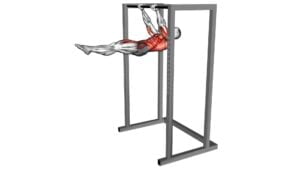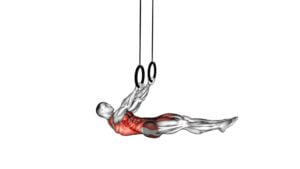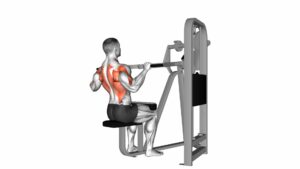Front Lever – Video Exercise Guide & Tips

Are you looking to master the front lever exercise? Look no further!
Watch This Exercise Video
In this video exercise guide, we'll show you everything you need to know. You'll discover the benefits of the front lever, learn proper form and technique, and find progression exercises for beginners.
We'll also explore advanced variations and challenges for those looking to take it to the next level. Avoid common mistakes, improve flexibility and strength with our expert tips!
Let's get started!
Key Takeaways
- The front lever provides immense strength and stability to core muscles.
- Progression exercises for beginners include starting with a tuck front lever hold and gradually increasing the duration of the hold as strength improves.
- Advanced variations and challenges, such as unique grip variations and one-arm front levers, can enhance strength and add difficulty to training.
- Proper form, technique, and avoiding common mistakes are crucial for preventing injury and maximizing the benefits of the front lever exercise.
Benefits of the Front Lever
To fully understand the benefits of the Front Lever, it's important for you to grasp the immense strength and stability it can provide to your core muscles. The Front Lever is a challenging exercise that requires great strength and control. It isn't only a great way to build a strong core, but it also engages multiple muscle groups, including the back, shoulders, and arms.
One of the benefits of the Front Lever is that it helps to improve your overall body strength. By performing front lever progressions, you're constantly challenging your muscles to work harder and become stronger. This exercise also helps to improve your stability and balance, as it requires you to hold your body in a horizontal position without any support.
To build strength for the Front Lever, it's important to focus on exercises that target the muscles involved in this movement. Pull-ups, rows, and core exercises such as planks and hollow holds can help to develop the necessary strength and stability. Gradually progressing from easier variations to more challenging ones will help you build the strength needed for the Front Lever.
Proper Form and Technique
To execute the front lever with proper form and technique, it's crucial to focus on optimal body positioning, engage your core effectively, and avoid common technique mistakes.
Maintaining a straight body line, with shoulders pulled down and back, is essential for achieving the correct body position.
Engaging your core muscles, specifically your abdominals and lower back, will provide the necessary stability and strength.
Optimal Body Positioning
Achieve optimal body positioning for the front lever by engaging your core, straightening your legs, and maintaining a strong and stable upper body.
To ensure proper form and technique, focus on the following:
- Optimal Breathing:
- Take deep breaths in and out throughout the exercise to supply your muscles with oxygen and maintain endurance.
- Exhale forcefully as you lift your legs, engaging your core and creating stability.
- Muscle Activation:
- Activate your core muscles by pulling your belly button towards your spine.
- Engage your shoulder and back muscles by squeezing your shoulder blades together.
By incorporating optimal breathing and muscle activation into your front lever, you'll enhance your overall performance and maximize the effectiveness of the exercise.
Remember to maintain proper form and technique to prevent injury and achieve the best results.
Core Engagement Importance
Maintain proper form and technique for optimal core engagement in the front lever by actively engaging your core and maintaining a stable upper body while performing the exercise. Core activation is crucial in the front lever as it helps stabilize your body and maintain control throughout the movement.
By engaging your core muscles, including the abdominals, obliques, and lower back, you create a strong foundation for the exercise. This core stability is essential for maintaining proper body alignment and preventing any unnecessary strain on your lower back. It also allows for better control and balance, enabling you to hold the front lever for a longer duration.
Proper core engagement ensures that you're effectively targeting your core muscles and maximizing the benefits of the front lever exercise.
Transitioning into the subsequent section about common technique mistakes, it's important to be aware of potential errors that could hinder your progress.
Common Technique Mistakes
Avoid these common technique mistakes to ensure proper form and technique when performing the front lever exercise.
- Improper breathing: It's essential to maintain proper breathing throughout the exercise. Avoid holding your breath or taking shallow breaths. Instead, focus on deep inhales and exhales to provide your muscles with the necessary oxygen and maintain stability.
- Incorrect shoulder placement: Proper shoulder placement is crucial for executing the front lever correctly. Avoid shrugging your shoulders or allowing them to round forward. Instead, engage your shoulder blades by pulling them down and back, creating a stable and strong foundation for the exercise. This will help prevent unnecessary strain on your shoulders and improve your overall form.
Progression Exercises for Beginners
How can you effectively progress in front lever exercises as a beginner?
To master the front lever, it's crucial to start with proper progressions and beginner front lever exercises. These exercises will help build the necessary strength and control required for the advanced front lever position.
One of the initial front lever progressions is the tuck front lever hold. Begin by hanging from a bar with an overhand grip and tuck your knees towards your chest. Slowly straighten your arms while maintaining the tucked position. Gradually increase the duration of the hold as you build strength.
Another effective exercise is the advanced tuck front lever. Similar to the tuck front lever hold, but this time, extend your legs slightly in front of you. Again, aim to increase the hold time as your strength improves.
As you progress, you can move on to the half lay front lever and eventually the full front lever. These exercises require increased core and upper body strength, so it's important to progress gradually to avoid injury.
Remember to always maintain proper form and engage your core muscles throughout each exercise. Consistency and patience are key to mastering the front lever as a beginner. With dedication and practice, you can achieve this impressive feat of strength.
Advanced Variations and Challenges
Now that you've mastered the basic front lever, it's time to take on some advanced variations and challenges.
One way to spice up your front lever routine is by trying out unique grip variations, such as the supinated grip or the false grip. These variations won't only target different muscle groups but also add an extra level of difficulty to your front lever training.
Additionally, if you're experiencing a strength plateau, incorporating advanced challenges like one-arm front levers or front lever pull-ups can help push your limits and continue progressing in your training.
Unique Grip Variations
Try incorporating unique grip variations into your front lever routine for a challenging and advanced experience. By utilizing alternative grips and grip training techniques, you can enhance your strength and stability while performing the front lever.
Here are some grip variations to consider:
- False grip: Instead of gripping the bar with your palms facing down, wrap your thumbs around the bar. This grip engages the forearms and increases the challenge of the exercise.
- Mixed grip: Place one hand in a pronated grip (palms facing down) and the other in a supinated grip (palms facing up). This grip can help with grip strength imbalances and provides a different challenge to your muscles.
Remember to always prioritize proper form and gradually progress to more advanced grip variations.
Incorporating these unique grips into your front lever routine won't only make it more challenging but also help you develop a well-rounded grip strength.
Overcoming Strength Plateaus
To continue building upon your front lever routine and overcome strength plateaus, incorporate advanced variations and challenges.
Breaking through plateaus requires programming for strength gains by introducing new and more difficult exercises. Advanced variations such as the straddle front lever, one-arm front lever, and front lever pull-ups can help you push past your limits and continue making progress. These variations challenge your muscles in different ways, providing a stimulus for growth and adaptation.
Additionally, you can incorporate challenges like weighted front lever holds or front lever negatives to further increase the intensity of your training. By consistently pushing yourself with these advanced variations and challenges, you can continue to improve your strength and achieve new milestones in your front lever journey.
Now, let's discuss some common mistakes to avoid in order to maximize your results.
Common Mistakes to Avoid
Avoid the common mistakes that can hinder your progress while performing the front lever exercise. To ensure proper execution of the front lever, it's essential to maintain proper body alignment and engage your shoulders effectively. Here are some common mistakes to avoid:
- Improper Body Alignment:
- Arching the lower back: Keep your core engaged and avoid excessive arching of the lower back. This will help maintain a straight line from your head to your toes.
- Dropping the hips: Make sure to keep your hips in line with your shoulders. Dropping the hips can lead to improper body alignment, making it harder to hold the front lever position.
- Lack of Shoulder Engagement:
- Passive shoulders: To achieve a stable front lever, actively engage your shoulder muscles. Pull your shoulder blades down and back, creating tension in the upper body.
- Rounded shoulders: Avoid rounded shoulders by focusing on retracting and depressing your shoulder blades. This will help maintain a strong and stable position throughout the exercise.
By avoiding these common mistakes and focusing on proper body alignment and shoulder engagement, you can maximize the effectiveness of your front lever training.
Remember to prioritize technique over intensity to achieve optimal results.
Tips for Improving Flexibility and Strength
To further enhance your progress in the front lever exercise, consistently incorporate exercises that improve flexibility and strength. Improving flexibility is crucial for achieving the correct body position and range of motion required for the front lever.
Incorporate stretching exercises that target the muscles involved in the front lever, such as the shoulders, back, and hamstrings. Perform exercises like shoulder dislocates, cat-cow stretches, and forward folds to increase flexibility in these areas.
In addition to flexibility, strengthening exercises are essential for building the necessary strength to hold the front lever position. Focus on exercises that target the core, back, and shoulders, as these are the primary muscle groups involved.
Incorporate exercises such as hollow holds, plank variations, and pull-ups to strengthen these areas. Gradually increase the difficulty and intensity of these exercises over time to continuously challenge and improve your strength.
Consistency is key when it comes to improving flexibility and strength for the front lever. Make sure to incorporate these exercises into your regular training routine and perform them consistently.
As you progress, monitor your flexibility and strength levels to track your improvement. With dedication and persistence, you'll gradually enhance your capability to perform the front lever with ease and control.
Frequently Asked Questions
Can the Front Lever Exercise Be Modified for Individuals With Limited Upper Body Strength?
Yes, the front lever exercise can be modified for individuals with limited upper body strength. There are modified variations that can help you build up to the full exercise.
For example, you can start by practicing tuck front levers or advanced tuck front levers, which require less upper body strength.
Additionally, alternative exercises like hanging leg raises or L-sits can also help strengthen your core and upper body.
Remember to progress gradually and listen to your body to avoid injury.
How Long Does It Typically Take to Achieve a Front Lever?
Achieving a front lever requires time and dedication.
It's important to understand that the time it takes varies for each individual. Some may achieve it within a few months, while others may take longer.
Consistency in training and proper technique are key to making progress.
Common mistakes include not engaging the core and using momentum.
It's crucial to focus on form and gradually increase the difficulty of the exercise to achieve the front lever.
Are There Any Specific Warm-Up Exercises Recommended Before Attempting the Front Lever?
Before attempting the front lever, it's important to do a specific warm-up to prepare your body. This will help prevent injuries and improve your performance.
Some recommended warm-up exercises include:
- Scapular pull-ups
- Hollow body holds
- Hanging leg raises
These exercises will activate the muscles needed for the front lever and increase your range of motion.
Additionally, you may want to consider starting with a front lever modification, such as tuck or straddle variations, before progressing to the full front lever.
Can the Front Lever Exercise Help Improve Core Strength and Stability?
Yes, the front lever exercise can definitely help improve core strength and stability.
By engaging your core muscles to hold your body in a horizontal position, you're actively strengthening and stabilizing your abdominal muscles, lower back, and hip flexors.
Additionally, the front lever requires a great deal of balance and body control, which can help improve your overall balance and increase flexibility in your shoulders and back.
Are There Any Specific Breathing Techniques That Should Be Used While Performing the Front Lever?
When performing the front lever, it's important to pay attention to your breathing techniques. Proper breathing can help you maintain stability and control throughout the exercise. Take deep breaths in and out, focusing on exhaling as you engage your core and lift your legs.
This will help you stay balanced and maintain control. Additionally, if you have limited strength, there are modifications you can make to gradually build up to the full front lever.
Conclusion
In conclusion, the front lever is a challenging exercise that offers numerous benefits for your core and upper body strength. By following proper form and technique, progressing through beginner exercises, and challenging yourself with advanced variations, you can improve your overall fitness level.
Avoiding common mistakes and focusing on flexibility and strength will help you achieve success in mastering the front lever. Keep practicing and pushing yourself to reach new levels of strength and skill.

Author
Years ago, the spark of my life’s passion ignited in my mind the moment I stepped into the local gym for the first time. The inaugural bead of perspiration, the initial endeavor, the very first surge of endorphins, and a sense of pride that washed over me post-workout marked the beginning of my deep-seated interest in strength sports, fitness, and sports nutrition. This very curiosity blossomed rapidly into a profound fascination, propelling me to earn a Master’s degree in Physical Education from the Academy of Physical Education in Krakow, followed by a Sports Manager diploma from the Jagiellonian University. My journey of growth led me to gain more specialized qualifications, such as being a certified personal trainer with a focus on sports dietetics, a lifeguard, and an instructor for wellness and corrective gymnastics. Theoretical knowledge paired seamlessly with practical experience, reinforcing my belief that the transformation of individuals under my guidance was also a reflection of my personal growth. This belief holds true even today. Each day, I strive to push the boundaries and explore new realms. These realms gently elevate me to greater heights. The unique combination of passion for my field and the continuous quest for growth fuels my drive to break new ground.



